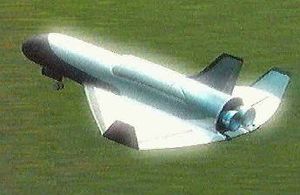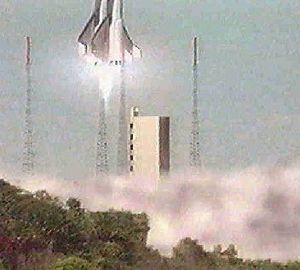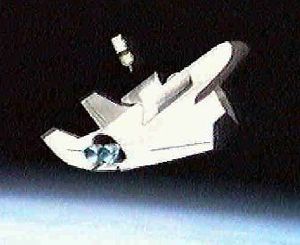
Home - Search - Browse - Alphabetic Index: 0- 1- 2- 3- 4- 5- 6- 7- 8- 9
A- B- C- D- E- F- G- H- I- J- K- L- M- N- O- P- Q- R- S- T- U- V- W- X- Y- Z
FLTP/FESTIP
 FLTP orbiter FLTP orbiter releases payload |
AKA: Ariane 6;FLTP;Future Launcher Technology Program. Status: Design 1999.
The study was led by CNES, and first flight was planned for 2020. The spacecraft was designated to be unmanned. But its configuration could include human cargo at a later point.
The FLTP program was launched at the interministerial conference of ESA in May 1999, with funding of $ 48 million for 1999 to 2001. This was to be followed by an 18 month period during which a technology demonstration program would be defined for approval at the ESA interministerial council in mid-2001. This demonstration program would run from 2002 to 2007, at which time a decision on Ariane 5's successor could be made. Two flying demonstrators were envisioned for the technology phase:
- EXTV (European eXperimental Test Vehicle). This was to be a reusable winged rocket-powered atmospheric reentry demonstrator capable of reaching speeds of Mach 4 to 10 in the atmosphere. The aim was to build up experience in reuse operations and high-speed atmospheric flight. The demonstrator would weigh two tons and have a range of 1500 kilometers. It would be able to land on a conventional runway. Dassault and Aerospatiale Matra were to merge their VEHRA and ARES projects to produce a single design. Ares estimated cost was 550 million dollars.
- Themis, a booster stage demonstrator, weighing 55 metric tons, to demonstrate integrated propellant tank technology. The demonstrator engine would be derived from the Vulcain of the Ariane 5. Estimated cost was up to 2.5 billion dollars. THEMIS would carry 33t of propellant, enough to reach Mach 11. Expendable boosters might permit orbital flight.
Development of the final commercial reusable launch vehicle (RLV) could cost between 7 to 16 billion dollars, up to twice that of Ariane 5. CNES calculations indicated that an RLV using Ariane 5 propulsion and materials technology would be no cheaper than the Ariane 5 itself. Therefore the need for the FLTP was clear to demonstrate new technology and provide the basis for a decision in 1997.
Thanks to Nicolas Pillet for providing images and information for this entry.
| Aerospatiale VTVL French SSTO VTOVL orbital launch vehicle. Aerospatiale vertical takeoff, vertical landing single stage to orbit study. |
| Astros German sled-launched winged orbital launch vehicle. Under the Future European Space Transportation Investigation Programme (FESTIP) of 1994-1999 French agencies and contractors designed a number of alternative reusable space launchers. This one was a Sled-launched horizontal takeoff / horizontal landing single stage to orbit. Essentially similar to FESTIP FSS-4 |
| DSL HTHL German winged orbital launch vehicle. Under the Future European Space Transportation Investigation Programme (FESTIP) of 1994-1999 French agencies and contractors designed a number of alternative reusable space launchers. This one was a Horizontal Takeoff / Horizontal Landing Two Stage to Orbit proposal with Mach 3 stage separation. Later evolved into the FESTIP FSS-11,which was merged with FSS-12. Reusable and expendable upper stage options. |
| Oriflamme French design for a scramjet-powered horizontal takeoff / horizontal landing, single stage to orbit vehicle. |
| Radiance French winged orbital launch vehicle. Two stage to orbit horizontal takeoff / horizontal landing vehicle. Booster would be powered by scramjets to Mach 12 separation before second stage separated. |
| RWDT HTHL German winged orbital launch vehicle. Under the Future European Space Transportation Investigation Programme (FESTIP) of 1994-1999 French agencies and contractors designed a number of alternative reusable space launchers. This one was a Horizontal Takeoff / Horizontal Landing Two Stage to Orbit proposal with Mach 4 stage separation. Vehicle consisted of an unpowered 'reusable winged drop tank' and 2-engine expendable Ariane-5 upper stage. |
| TARANIS French study of vertical takeoff / horizontal landing, two stage to orbit launch vehicle with expendable orbiter fuel tanks. |
| Themis launch vehicle French winged orbital launch vehicle. Themis was a planned ESA booster stage demonstrator, to validate integrated propellant tank technology necessary for a reusable Ariane 5 successor. The demonstrator engine would be derived from the Vulcain of the Ariane 5. Estimated cost was up to 2.5 billion dollars. THEMIS would carry 33 metric tons of propellant, enough to reach Mach 11. Expendable boosters might permit orbital flight. |
| EXTV French winged orbital launch vehicle. This was to be a reusable winged rocket-powered atmospheric reentry demonstrator capable of reaching speeds of Mach 4 to 10 in the atmosphere. The aim was for ESA to build up experience in reuse operations and high-speed atmospheric flight in the 2003-2007 period. The demonstrator would weigh two metric tons and have a range of 1500 kilometers. It would be able to land on a conventional runway. Dassault and Aerospatiale Matra were to merge their VEHRA and ARES projects to produce a single design. Ares estimated cost was 550 million dollars. |
| Vehra French air-launched rocketplane. Dassault design for an air-launched experimental reusable launch vehicle. It would be launched from Novespace's Airbus 300 zero-G aircraft. The lifting-body design was loosely based on Dassault's work on the NASA-led X-38 Crew Rescue Vehicle program. VEHRA weighed 6.5 t metric tons and carried 19.5 metric tons of kerosene and oxygen propellant. One Russian 400.5 kN-thrust NK-39 engine would power the vehicle, which would be capable of reaching Mach 14. The 11.5 meter long vehicle also contained a small 1.5 x 1.5 x 5 meter payload bay for an expendable upper stage+250 kg satellite. Like THEMIS, VEHRA would explore hypersonic flight and the operational and cost aspects of reusability. |
| Ares spaceplane French spaceplane. Study 1998. Small 7-meter long delta wing spaceplane, proposed by Aerospatiale, weighing 2,000 kg. Launched 2009.10.28, |
Family: orbital launch vehicle, Winged. Country: Europe. Agency: ESA. Bibliography: 485.
 | FLTP landing FLTP orbiter lands |
 | FLTP Launch FLTP Reusable Launch Vehicle Launch |
 | FLTP Separation Separation of Booster and Orbiter stages of European FLTP |
2009 October 28 - . Launch Site: Cape Canaveral. Launch Complex: Cape Canaveral LC39B. Launch Platform: MLP1. LV Family: Shuttle. Launch Vehicle: Ares I-X.
- Ares I-X - .
Nation: USA.
Agency: Clemson.
Spacecraft Bus: FLTP/FESTIP.
Spacecraft: Ares spaceplane.
First flight test of the Ares/Constellation program. The Ares I-X rocket consisted of the modified Shuttle RSRM-91A solid rocket booster, a dummy Upper Stage Simulator, and a dummy Ares command module / launch abort system. It was launched from the newly modified LC39B at Kennedy Space Center to test the aerodynamics of the vehicle within the atmosphere and provide real-world data to ameliorate concerns regarding the vibration level created by the SRB for any crew in a future mission. The SRB reached 46 km altitude before descending to the Atlantic for recovery.
Back to top of page
Home - Search - Browse - Alphabetic Index: 0- 1- 2- 3- 4- 5- 6- 7- 8- 9
A- B- C- D- E- F- G- H- I- J- K- L- M- N- O- P- Q- R- S- T- U- V- W- X- Y- Z
© 1997-2019 Mark Wade - Contact
© / Conditions for Use